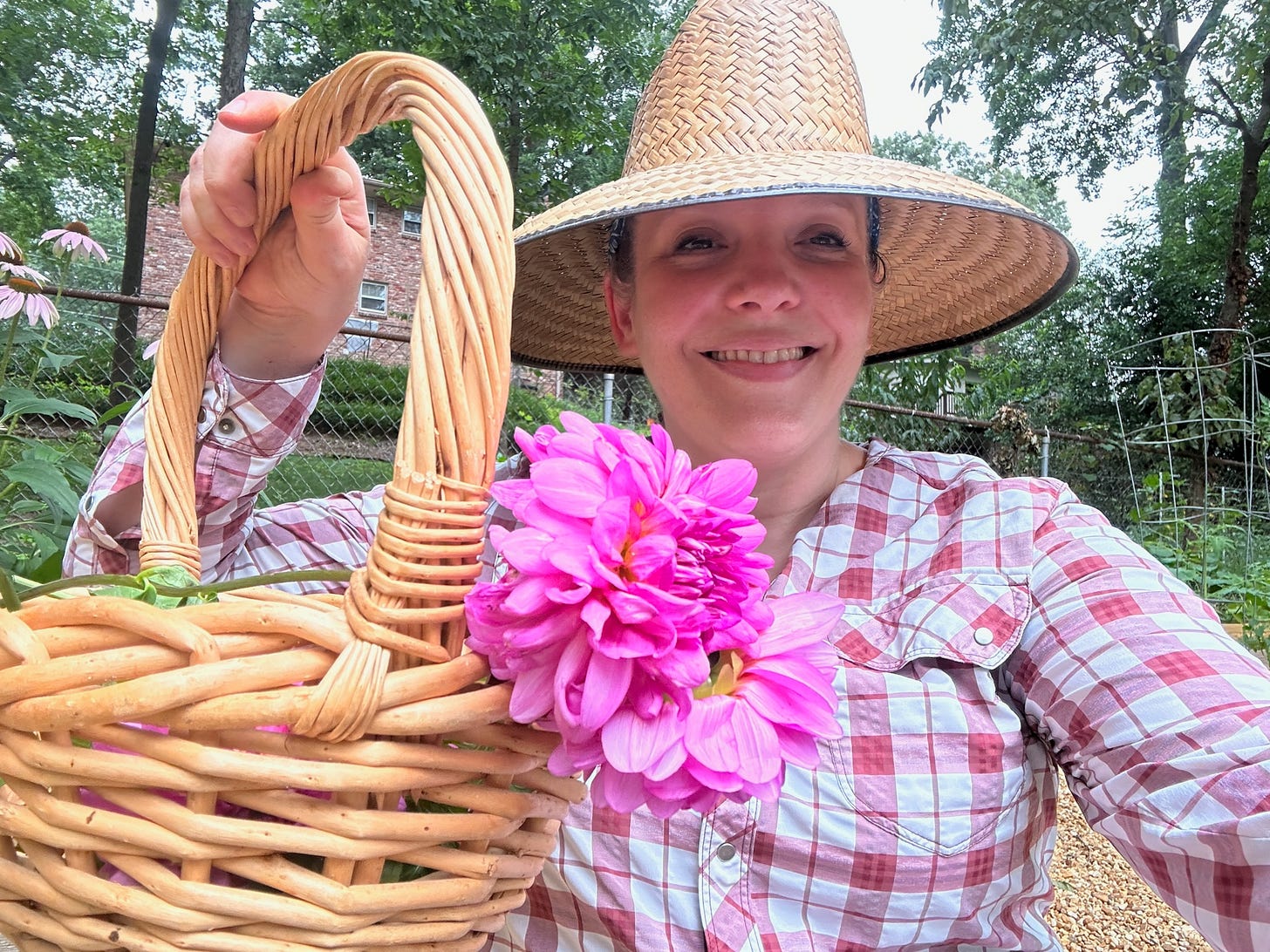Notes from my summer garden
I offer a peek into my home garden and share which plants I grow to support a healthy diet.
Happy Fourth of July! I spent the weekend wrangling tomatoes into cages, weeding interlopers in my raised beds, and delighting in these lovely dahlias in the photo above. I’m a big believer in ‘practicing what you preach.’ If you’ve read this newsletter for a while, you’ll know I am a big fan of integrating nature into health and wellness routines.
My garden is a place of respite from the business of my routine. It’s also where I stretch and exercise, bending up and down or crawling around as I pluck weeds. It’s where my husband and I relax and chat at the end of the day with a cup of tea or a glass of wine.
The garden design
I got an early start in planting this spring. We have plenty of rain and sunshine in Atlanta, but growing in a suburban environment here presents some challenges due to tree cover and shade. We have sixteen 3x8' raised beds for vegetables in our garden, with half of these in full sun, four in partial shade, and two in the shade (the trickiest ones to grow in!). We also have three 2x8' beds for garden herbs and a 1.5’-wide strip along the fence line for flowers (dahlias, daisies, sunflowers, clematis). The garden is on a slight upward slope, which ensures better sun exposure for the beds in the back. You'll note I have two beds labeled “shade problems” in the back right corner. No matter what I've tried, these beds just never really do well. This year, I found some tomato volunteers that popped up in the beds among the weeds, and I've decided to see how they do.
Do you have any advice on good shade-hardy plants for these beds?
What’s growing
June gave the garden a great kickstart and we have plenty of tomatoes, peppers, and eggplants developing, but not ready for harvest yet. The herbs of the Lamiaceae (mint) family are overflowing in their beds and one of my projects this week will be to harvest the tops (around 1-1.5’ of each), rinse and hang to dry for use in teas throughout the year. My Apiaceae herbs (parsley and cilantro) are also doing well. We have an abundance of cucumbers and in addition to using them daily in salads, I’ve also begun to pickle them for later use. My onion bed is also thriving. This is one of my favorite beds because after a harvest, I simply replant the roots to get a new crop of green onion tops.
Garden dish of the week
Here’s one of my favorite dishes made this week based mainly on ingredients grown in the garden: tabbouleh salad.
Garden ingredients:
Curled leaf parsley: 1 extra large handful
Peppermint: 5 stems with fresh leaves
Cucumber: 1 or 2 medium-sized
Green onions: 1 or 2 with crisp green tops
Store-bought ingredients:
Tomatoes: 1 medium or large tomato or a handful of cherry tomatoes. Mine aren’t quite ready in the garden yet, but you could make this later in summer with a vine-ripened garden harvest.
Bulgur wheat (fine couscous), half a cup
Olive oil to taste
Lemon (1)
Salt to taste
Black pepper (fresh ground, to taste)
Hot water (enough to cover the bulgur - 2 cups)
Recipe Instructions:
Combine the water and bulgur in a bowl and let sit for 5-7 minutes, then remove the water in a fine-mesh colander and squeeze out excess water.
Rinse the veggies and dice them into small squares—place in a colander to drain off the tomato water.
Rinse and pat dry the herbs, then finely chop them.
Place all of the prepared ingredients in a bowl. Squeeze the juice of one lemon on top, add olive oil to taste (1-2 tablespoons), a pinch of salt, and a few grinds of black pepper.
Mix the ingredients well. Cover and place in the fridge for at least 30 minutes before eating it to enjoy the best flavor.
Bon Appetit and Happy 4th!
Yours in health, Dr. Quave
Cassandra L. Quave, Ph.D. is a scientist, author, speaker, podcast host, wife, mother, explorer, and professor at Emory University School of Medicine. She teaches college courses and leads a group of research scientists studying medicinal plants to find new life-saving drugs from nature. She hosts the Foodie Pharmacology podcast and writes the Nature’s Pharmacy newsletter to share the science behind natural medicines. To support her effort, consider a paid or founding subscription, with founding members receiving an autographed 1st edition hardcover copy of her book, The Plant Hunter.






